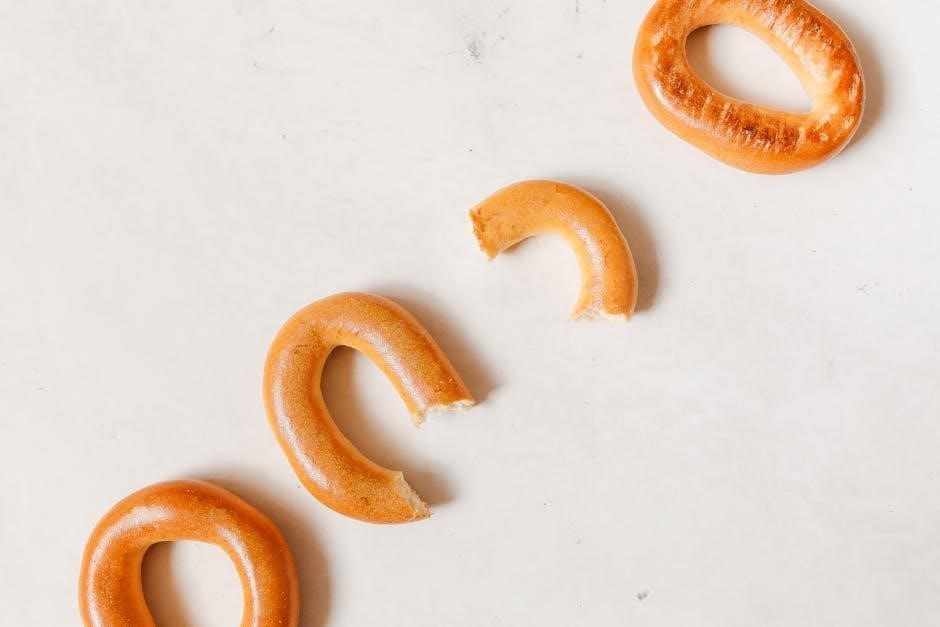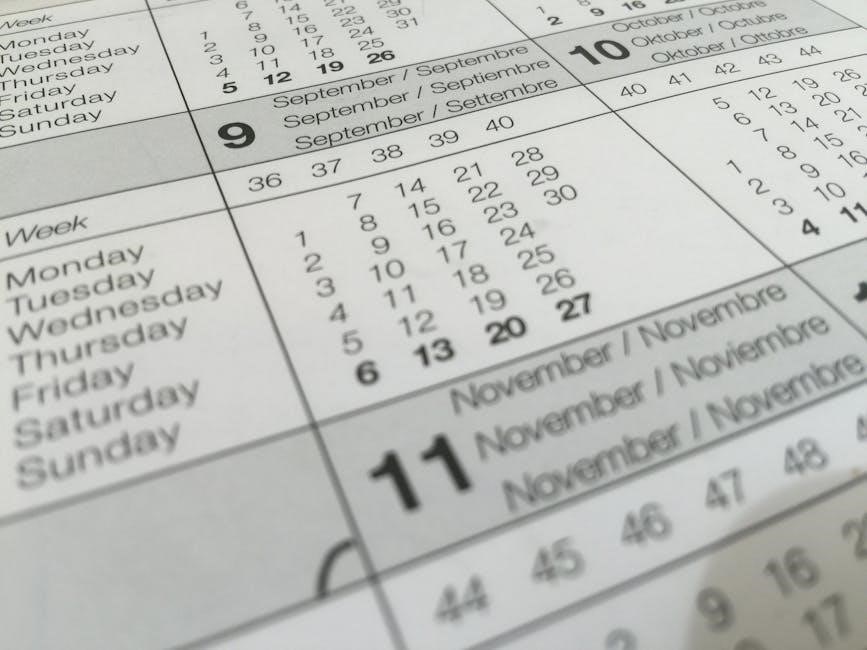Carb cycling is a dietary strategy alternating carbohydrate intake to optimize fat loss and performance. A structured 12-week meal plan offers a practical guide to achieving these goals effectively.
What is Carb Cycling?
Carb cycling is a dietary strategy that involves alternating carbohydrate intake to optimize fat loss, muscle growth, and performance. It manipulates macronutrient consumption by cycling between high-carb and low-carb days to influence metabolic processes. This approach aligns carb intake with energy needs, fueling workouts on high-carb days and promoting fat burning on low-carb days. By strategically varying carb consumption, individuals can enhance metabolic flexibility, improve insulin sensitivity, and maintain muscle mass. Carb cycling is popular among athletes and fitness enthusiasts seeking to achieve specific physique or performance goals, offering a structured yet adaptable framework for sustainable results. It is not a one-size-fits-all method but requires customization based on individual needs and objectives.
Benefits of Carb Cycling
Carb cycling offers numerous benefits, including enhanced fat loss, improved insulin sensitivity, and better muscle preservation. By alternating carbohydrate intake, the body becomes more efficient at burning fat during low-carb phases and utilizing carbs effectively during high-carb phases. This metabolic flexibility supports sustained weight loss and a leaner physique. Additionally, carb cycling helps maintain muscle mass by providing energy for intense workouts and recovery. It also reduces cravings and improves dietary adherence, making it easier to stick to long-term nutrition goals. Furthermore, carb cycling enhances athletic performance by fueling workouts and improving endurance. Overall, it is a versatile and effective strategy for achieving fat loss, muscle growth, and improved metabolic health.
Why a 12-Week Plan?
A 12-week carb cycling plan provides a structured and sustainable approach to achieving fitness goals. This duration allows for gradual physiological adaptations, ensuring fat loss and muscle preservation without plateauing. The plan is divided into phases, each targeting specific objectives, such as increasing intensity or maintaining results. It offers enough time to develop healthy habits and see noticeable changes while keeping motivation high. The 12-week timeframe is also long enough to avoid metabolic stagnation, ensuring continuous progress. With a printable PDF guide, individuals can easily follow the plan, making it a practical and effective solution for those seeking a balanced and achievable nutrition strategy.

Understanding Macronutrients
Macronutrients—carbohydrates, proteins, and fats—are essential for energy, tissue repair, and hormone production, forming the foundation of a balanced diet in carb cycling plans.
Carbohydrates: The Primary Energy Source
Carbohydrates are the body’s primary energy source, composed of carbon, hydrogen, and oxygen. They come in two forms: simple carbs (sugars) and complex carbs (starches, fibers). Simple carbs are quickly digested, while complex carbs provide sustained energy. In a carb cycling meal plan, carbohydrates are strategically manipulated to fuel workouts, replenish glycogen stores, and support recovery. High-carb days typically include whole grains, legumes, and vegetables, offering essential nutrients and fiber. Timing carbohydrate intake around workouts maximizes energy and recovery. Choosing the right carbs, such as whole, unprocessed foods, ensures steady energy levels and supports overall health. This approach avoids refined carbs, which can hinder progress and cause energy crashes.
Proteins: Building and Repairing Tissues
Proteins are essential for building and repairing tissues, making them a cornerstone of a carb cycling meal plan. They provide the building blocks for muscle growth and maintenance, which is critical during both high-carb and low-carb phases. Lean protein sources like chicken, fish, eggs, and legumes are emphasized to support muscle recovery without excess calories. Protein intake helps preserve muscle mass during fat-loss phases and supports muscle synthesis during high-intensity workouts. Aiming for 1.2–2.2 grams of protein per kilogram of body weight daily ensures adequate muscle support. Incorporating diverse protein sources ensures a balanced diet, while timing protein intake around workouts enhances recovery and muscle maintenance.
Fats: Essential for Hormone Production
Fats are a vital component of a carb cycling meal plan, playing a crucial role in hormone production and overall metabolic health. Healthy fats, such as avocados, nuts, and olive oil, support the production of essential hormones like testosterone and cortisol, which are critical for energy and recovery. During low-carb phases, fats become a primary energy source, aiding in fat loss and maintaining satiety. Incorporating the right balance of saturated, monounsaturated, and polyunsaturated fats ensures proper bodily functions and prevents deficiencies. Aiming for 0.5–1 gram of fat per pound of body weight daily strikes a balance between energy needs and fat loss goals, making fats indispensable in a structured meal plan.

How Carb Cycling Works
Carb cycling works by alternating carbohydrate intake to optimize energy use and fat burning. High-carb days fuel workouts, while low-carb days enhance fat metabolism.
High-Carb Days: Fueling Workouts
High-carb days are designed to replenish glycogen stores and provide energy for intense workouts. They typically align with training days, ensuring optimal performance and endurance. During these days, complex carbohydrates like whole grains, legumes, and vegetables are prioritized to sustain energy levels. The goal is to maximize glycogen storage, which fuels muscles during exercise. Adequate carbohydrate intake also supports muscle recovery, reducing soreness and improving adaptability for future workouts. By timing carb consumption around workouts, individuals can enhance energy availability and recovery efficiency, making high-carb days a cornerstone of carb cycling for fitness enthusiasts and athletes aiming to optimize their training results.
Low-Carb Days: Promoting Fat Loss
Low-carb days are tailored to deplete glycogen stores, shifting the body to burn fat for energy. This phase is crucial for fat loss, as it enhances the body’s ability to utilize stored fat reserves. On these days, carbohydrate intake is significantly reduced, focusing on protein and healthy fats to maintain satiety and support muscle preservation. Fibrous vegetables, lean meats, and low-carb alternatives are emphasized to keep nutrient intake high while minimizing carb consumption. Timing low-carb days around rest or light activity maximizes fat metabolism. Proper hydration and electrolyte balance are essential to avoid fatigue and support overall well-being during this phase. This strategic approach helps accelerate fat loss while maintaining metabolic efficiency.
Maintenance Days: Balancing Nutrition
Maintenance days are designed to balance nutrition, ensuring the body stays in a stable metabolic state. These days typically involve moderate carbohydrate intake, aligning with the body’s energy needs without overloading or depleting glycogen stores. The focus is on maintaining weight and supporting overall health by balancing macronutrients. Protein and healthy fats remain priorities to preserve muscle mass and satisfy hunger. Maintenance days help prevent metabolic stagnation and keep the body responsive to carb cycling. They are often used during phases where fat loss and muscle maintenance are equally important. This balanced approach ensures long-term sustainability and prevents extreme fluctuations in energy levels or body composition.

Structuring Your 12-Week Carb Cycling Meal Plan
A well-structured 12-week carb cycling plan divides into phases, each with specific carb intake levels and goals, ensuring gradual progress toward fat loss and muscle maintenance.
Phase 1 introduces the basics of carb cycling, helping your body adapt to fluctuating carbohydrate intake. Weeks 1-4 focus on establishing a routine with high-carb and low-carb days, teaching your body to use carbs efficiently. This phase sets a foundation for fat loss and muscle maintenance by balancing macronutrients and hydration. Start with moderate carb intake, gradually adjusting based on progress. Emphasize whole foods, portion control, and meal timing. This initial phase is crucial for building discipline and understanding how your body responds to carb cycling. Tracking progress and adjusting macronutrient ratios ensures a smooth transition into more intensive phases later in the plan.
Phase 2: Weeks 5-8 – Increasing Intensity
Phase 2 ramps up the intensity by refining your carb cycling strategy. Weeks 5-8 focus on optimizing macronutrient ratios and timing to enhance fat loss and performance. Expect more defined high-carb and low-carb days, with a greater emphasis on workout fueling. This phase introduces slightly lower carb intake on rest days to accelerate fat burning, while high-carb days align with intense workouts. Protein and fat intake remain balanced to preserve muscle mass. Hydration and electrolyte management become critical as your body adapts to higher energy demands. Tracking progress is essential to fine-tune your plan, ensuring you’re on track to meet your goals; This phase builds momentum for the final push in Phase 3.
Phase 3: Weeks 9-12 – Final Push and Maintenance
Phase 3 is designed to maximize results and transition into maintenance. Weeks 9-12 focus on refining your carb cycling strategy, with an emphasis on stabilization. High-intensity workouts are paired with precise macronutrient adjustments to ensure continued progress. Carb intake is fine-tuned to maintain fat loss while preserving muscle. Maintenance days are introduced to balance nutrition and prevent plateaus. This phase also prepares your body for long-term sustainability by gradually adjusting to a balanced macronutrient intake. Tracking progress becomes crucial, with adjustments made to ensure goals are met. By the end of Phase 3, you’ll have a clear roadmap for maintaining your results and adapting the plan to your lifestyle.

Sample Meal Plans
Discover structured high-carb, low-carb, and maintenance meal plans tailored for a 12-week cycle, ensuring balanced nutrition and sustained progress toward your fitness goals.
High-Carb Day Meal Plan
A high-carb day focuses on replenishing energy stores and fueling intense workouts. Start with oatmeal topped with berries and a drizzle of honey for breakfast. For lunch, opt for quinoa salad with grilled chicken, mixed vegetables, and a vinaigrette dressing. Dinner could include sweet potato mash, lean beef, and steamed broccoli. Snacks like whole-grain crackers with almond butter or an apple with peanut butter are ideal. Prioritize complex carbs such as whole grains, fruits, and legumes to maintain steady energy levels. Timing carbs around workouts maximizes glycogen replenishment and muscle recovery. This structured approach ensures you meet your energy needs while supporting fitness goals. Consistency and proper planning are key to making the most of high-carb days in your 12-week cycle.
Low-Carb Day Meal Plan
A low-carb day focuses on fat utilization and weight loss. Begin with a protein shake or scrambled eggs for breakfast. Lunch could include grilled chicken or fish with a side of mixed greens and avocado. Dinner might feature lean beef or pork with roasted vegetables like Brussels sprouts and cauliflower. Snacks such as hard-boiled eggs, cheese, or a handful of nuts are ideal. Avoid sugary foods and refined carbs, opting instead for whole, nutrient-dense options. This plan supports fat metabolism while maintaining muscle mass. Proper hydration and electrolyte balance are crucial to avoid fatigue. A well-structured low-carb day meal plan ensures progress toward your fitness and weight loss goals within the 12-week cycle.
Maintenance Day Meal Plan
A maintenance day meal plan strikes a balance between high and low-carb intake, aiming to sustain progress without extreme restrictions. Breakfast might include scrambled eggs with spinach and avocado, while lunch could feature grilled chicken with a mix of vegetables and a small portion of complex carbs like quinoa. Dinner options include baked salmon with asparagus and a side salad. Snacks like nuts or veggie sticks with hummus are ideal. This approach maintains metabolic balance, preventing plateaus while supporting fat loss and muscle retention. The focus is on nutrient-dense foods, ensuring sustained energy and satisfaction without over-restricting carbohydrates. This balanced strategy is key to long-term success in a carb cycling regimen.

Grocery List and Meal Prep
A well-organized grocery list and meal prep routine are essential for success. Focus on whole foods, lean proteins, and balanced carbs to stay on track with your plan.
Essential Foods for High-Carb Days
High-carb days in your 12-week meal plan should focus on nutrient-dense, complex carbohydrates to fuel workouts and replenish energy stores. Include whole grains like oats, brown rice, and quinoa, as well as starchy vegetables such as sweet potatoes and yams. Legumes, like lentils and chickpeas, are also great sources of sustained energy. Fresh fruits, such as bananas, berries, and apples, provide natural sugars and essential vitamins. Whole-grain bread, pasta, and cereals are excellent for pre-workout meals. Prioritize unprocessed foods to avoid rapid blood sugar spikes. Pair carbs with lean proteins and healthy fats for balanced meals. Meal prepping these staples ensures convenience and adherence to your high-carb days, keeping you energized and focused throughout your fitness journey.
Essential Foods for Low-Carb Days
On low-carb days, focus on protein-rich foods, healthy fats, and non-starchy vegetables to promote fat loss and maintain muscle. Include lean meats like chicken, turkey, and fish, as well as eggs and tofu for plant-based options. Healthy fats such as avocados, nuts, seeds, and olive oil are crucial for energy and hormone production. Non-starchy vegetables like broccoli, spinach, cauliflower, and zucchini provide essential vitamins and fiber without excessive carbs. Low-carb dairy options, such as Greek yogurt and cottage cheese, can also be incorporated in moderation. Avoid sugary, processed foods and focus on whole, nutrient-dense ingredients to support your goals. This balance ensures you stay satisfied and fueled while optimizing fat loss during low-carb phases of your 12-week plan.
Meal Prep Tips for Success
Meal prep is key to sticking with your 12-week carb cycling plan. Start by planning your meals weekly, ensuring alignment with high-carb and low-carb days. Cook proteins like chicken, fish, and eggs in bulk, portion them, and store in airtight containers. Prep non-starchy vegetables like broccoli and cauliflower in advance for easy access. Use portion control to maintain macronutrient balance. Keep healthy fats like nuts and avocados on hand for quick additions. Incorporate low-carb snacks to avoid cravings. Stay hydrated with water and electrolyte-rich drinks, especially on low-carb days. Finally, label and date all prepped meals for clarity and freshness. Consistency in meal prep will help you stay on track and achieve your fitness goals seamlessly.
Timing Your Carbohydrate Intake
Timing carbohydrate intake is crucial for optimizing energy and fat loss. Consume carbs around workouts to fuel performance and recovery, focusing on complex carbs for sustained energy and simple carbs for quick boosts. Adjust carb intake based on activity level and goals, ensuring balance with protein and fats. Stay hydrated and monitor electrolytes, especially on low-carb days. Track progress through weight, body fat, and performance metrics to refine your strategy and ensure success in your 12-week plan.
Pre-Workout Carbohydrate Consumption
Consuming carbohydrates before a workout is essential for optimizing energy levels and performance. Focus on complex carbs like oats or whole grains 30-60 minutes pre-workout to provide sustained energy. Simple carbs, such as fruits or sports drinks, can be consumed 15-30 minutes before training for a quick energy boost. Pairing carbs with a small amount of protein helps stabilize blood sugar and supports muscle maintenance. Timing and type of carbs should align with workout intensity and duration. This strategy ensures you’re fueled for peak performance while supporting your 12-week carb cycling plan’s goals. Proper pre-workout nutrition enhances endurance, strength, and recovery, making it a cornerstone of your fitness routine.
Post-Workout Recovery Nutrition
Post-workout recovery nutrition is critical for replenishing energy stores and repairing muscle tissue. Within 30-60 minutes after exercise, consume a mix of carbohydrates and protein to restore glycogen and support muscle repair. Aim for a carb-to-protein ratio of 2:1 or 3:1, depending on intensity. Simple carbs like bananas or sweet potatoes pair well with lean proteins such as whey or Greek yogurt. This combination helps reduce muscle soreness, promotes recovery, and supports muscle growth. Staying hydrated and including electrolytes, like sodium and potassium, is also essential for replenishing lost fluids and salts. Proper post-workout nutrition aligns with your 12-week carb cycling plan, ensuring optimal recovery and progress toward your fitness goals.
Optimizing Carbohydrate Intake for Fat Loss
Optimizing carbohydrate intake for fat loss involves strategically timing and portioning carbs to maximize fat burning while maintaining energy levels. By cycling between high and low-carb days, you train your body to efficiently use fat as fuel during low-carb phases. Focus on complex carbs like whole grains, vegetables, and legumes, which provide sustained energy and fiber. Timing carbs around workouts can enhance fat oxidation, as pre-workout carbs fuel intensity, while post-workout carbs aid recovery. Balancing carb intake with protein and fats ensures metabolic balance and prevents muscle loss. Consistency and customization are key, as individual metabolic responses vary. This structured approach in a 12-week plan helps maintain fat loss momentum without sacrificing performance or muscle mass, making it a sustainable strategy for long-term success.

Hydration and Electrolyte Balance
Hydration and electrolyte balance are crucial for preventing fatigue and muscle cramps, especially on low-carb days. Proper fluid and electrolyte intake supports overall health and workout performance.
Importance of Hydration in Carb Cycling
Hydration is essential for overall health and plays a critical role in carb cycling. Proper water intake helps maintain energy levels, supports digestion, and prevents muscle cramps or fatigue. On low-carb days, the body sheds excess water, increasing the risk of dehydration. even mild dehydration can impair physical performance and slow metabolism. Drinking plenty of water ensures electrolytes are balanced, which is vital for nerve function and muscle contractions. Staying hydrated also aids in appetite control and fat loss, as water helps flush toxins and maintain efficient bodily functions. Incorporating electrolyte-rich beverages or supplements, especially during low-carb phases, can help maintain optimal hydration and support overall success in your 12-week meal plan.
Managing Electrolytes on Low-Carb Days
On low-carb days, managing electrolytes is crucial to prevent dehydration and muscle cramps. Sodium, potassium, and magnesium levels drop due to reduced water retention. Incorporate electrolyte-rich foods like avocados, nuts, and cheeses. Consider supplements or broths to maintain balance. Monitor symptoms like fatigue and adjust intake accordingly. Balance hydration with electrolyte consumption to avoid overhydration. Adjust strategies based on meal plan guidelines and track symptoms to ensure optimal levels, supporting overall health and performance during the 12-week plan.

Tracking Progress
Regularly monitor weight, body fat percentage, and measurements to track progress. Consistency in tracking helps identify patterns and adjustments needed to stay on course with your goals effectively.
Monitoring Weight and Body Fat
Tracking weight and body fat regularly is crucial for assessing progress in your 12-week carb cycling plan. Use a reliable scale and body fat calipers weekly to measure changes accurately. Consistency is key—weigh yourself under the same conditions each time to avoid fluctuations caused by hydration or glycogen levels. Monitoring body fat percentage helps determine if fat loss is occurring while maintaining muscle mass. Keep a journal to record weekly measurements and adjustments to your meal plan. This data provides insights into your metabolic response to carb cycling, enabling fine-tuned adjustments for optimal results. Regular tracking helps maintain accountability and motivates adherence to your dietary and fitness goals.
Adjusting Macronutrient Ratios
Adjusting macronutrient ratios is essential for optimizing results in your 12-week carb cycling plan. Start by assessing your progress, then tweak your carbohydrate, protein, and fat intake based on your goals. For fat loss, slightly reduce carb intake on low-carb days or increase protein to preserve muscle. If muscle gain is a priority, ensure high-carb days provide sufficient calories and carbs to fuel growth. Monitor how your body responds and make incremental changes. Tracking tools or apps can help maintain precision. Regular adjustments ensure your macronutrient balance aligns with your evolving needs, keeping your metabolism responsive and preventing plateaus. Fine-tuning these ratios is key to achieving long-term success.
Fine-Tuning Your Meal Plan
Fine-tuning your meal plan is crucial for maximizing results in your 12-week carb cycling journey. Regularly monitor your progress, energy levels, and how your body responds to different carb phases. Make small adjustments to portion sizes or macronutrient ratios based on your goals. For example, if weight loss stalls, slightly reduce calorie intake on low-carb days or increase protein to maintain muscle. If you’re feeling fatigued, ensure you’re consuming enough carbs on high-carb days. Personalize your meals by swapping ingredients while keeping macros balanced. Consistency is key, but flexibility ensures sustainability. Use tracking tools to log your meals and progress, allowing you to make data-driven decisions. Over time, these tweaks will refine your plan, ensuring it aligns perfectly with your evolving needs and goals.

Final Thoughts
A well-structured 12-week carb cycling meal plan offers a sustainable path to fat loss, muscle maintenance, and improved metabolic health, helping you achieve lasting fitness goals effectively.
Long-Term Sustainability of Carb Cycling
Carb cycling is a highly sustainable approach for long-term health and fitness. Unlike restrictive diets, it allows for flexibility and adaptation, making it easier to maintain over time. The structured 12-week meal plan helps individuals develop healthy eating habits and metabolic balance. By cycling carbs strategically, the body adapts to using both carbohydrates and fats efficiently, enhancing metabolic flexibility. This method also encourages mindful eating and portion control, which are key for sustaining weight loss and overall well-being. With proper planning and adherence, carb cycling can become a lifelong nutrition strategy, promoting continuous progress toward fitness and health goals without feeling deprived or restricted.
Maintaining Results After the 12-Week Plan
Maintaining results after completing a 12-week carb cycling plan requires a commitment to sustainable habits. Gradually transition to a balanced diet while continuing to cycle carbs at a lower intensity. Focus on mindful eating and portion control to avoid overconsumption of calories. Incorporate regular physical activity to sustain muscle mass and metabolic health. Periodically reintroduce carb cycling phases to maintain fat loss and prevent plateaus. Stay hydrated, monitor electrolytes, and track progress to ensure long-term success. By adapting the principles of carb cycling into a lifestyle, individuals can preserve their results and continue progressing toward their health and fitness goals without feeling restricted or deprived.

Getting Your Printable 12-Week Carb Cycling Meal Plan PDF
Transform your fitness journey with a downloadable printable 12-week carb cycling meal plan PDF. This comprehensive guide provides a structured approach to nutrition, offering detailed meal plans, macronutrient breakdowns, and delicious recipes. Designed for sustainability, the PDF includes high-carb, low-carb, and maintenance day strategies to support fat loss, muscle growth, and energy optimization. Perfect for athletes and fitness enthusiasts, it ensures flexibility to suit various lifestyles and goals. With expert tips and customizable options, this plan helps you stay on track and achieve lasting results. Download your free PDF today and take the first step toward a healthier, more balanced you!




